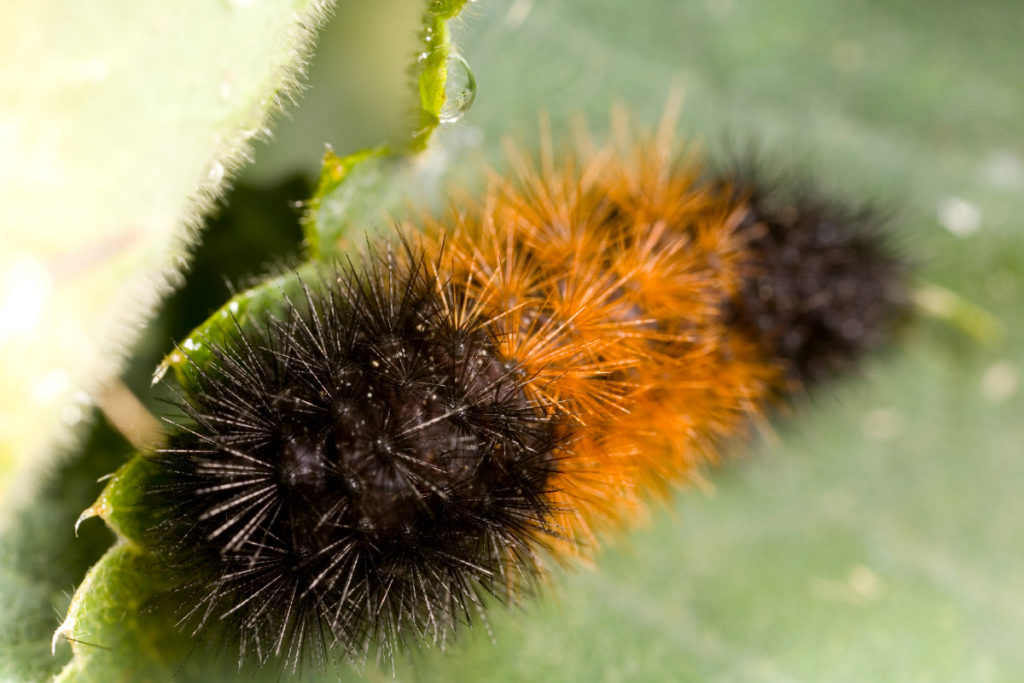Welcome back to the Lab!
Insect-inspired folklore is rampant throughout human history; from the ancient Egyptians, who believed bees were the sacred tears of the sun god, Ra, to the many cultures who revered the praying mantis as a spiritual guide. Some of these legends persist in the modern day, and I would argue that none are more widely known than the winter prediction capabilities of the woolly bear caterpillar.
The term “woolly bear caterpillar” is a common name that can refer to more than one species of moth. Generally speaking though, “woolly bear” refers to the species Pyrrharctia isabella, the Isabella tiger moth, whose larval form is the familiar, brown-and-black banded fuzzball whose weather prediction skills are… questionable.
The legend goes that the 13 segments of the caterpillars body represent the 13 weeks of winter. The width of the brown and black bands correspond with the severeity; The wider the rusty brown sections (or the more brown segments there are), the milder the coming winter will be. The more black there is, the more severe the winter.

The tale was so persistent that in 1948, Dr. C. H. Curran, the curator of insects at the American Museum of Natural History in New York City, decided to put it to the test.
Over the course of 8 years, Dr. Curran collected and measured the brown banding on woolly bear caterpillars and compared the average width of the brown bands to the severity of that year’s winter. During those 8 years, the brown bands measured, on average, over 1/3rd of the caterpillars’ total body length, and the winters were, in turn, fairly mild those years.

So, was this evidence enough to convince Dr. Curran that woolly bears can predict the weather?
Not so much.
Dr. Curran knew his sample sizes were too small to produce any kind of significant data, and the experiment was more of a fun excuse to drive north and see the foliage each fall with his wife and friends. They even dubbed themselves the The Original Society of the Friends of the Woolly Bear.
Nevertheless, the folktale has persisted, and their legacy lives on in the many festivals that celebrate them.

And why shouldn’t we celebrate this caterpillar? They may not be meteorologists but they are fascinating (and adorable!) in their own right.
The woolly bear survives winter in its larval form, a rarity amongst insects. It is also one of few northern hemisphere insects to practice freeze tolerance, pumping its body full of cryoprotectants at the onset of cold weather, freezing solid, and thawing in the spring to pupate.
However extreme this overwintering strategy may seem, it doesn’t hold a candle to its relative, the arctic woolly bear caterpillar.

The arctic woolly bear, Gynaephora groenlandica, is native to the High Arctic, where the growing season is short and the winters last for much of the calendar year. In order for the caterpillar to reach the size required to trigger pupation, the caterpillar must feed voraciously… for 7 years.
The arctic woolly caterpillar is indeed a long-lived lepidopteran, undergoing the freeze/thaw cycle for an average of 7 springs before it has consumed enough foliage to reach the appropriate size. Sleep, gorge, rinse and repeat. What a life.
Until next time, thanks for visiting the lab!
Bug Wrangler Brenna
brenna@missoulabutterflyhouse.org
Want to revisit a previous Notes from the Lab issue? Check out our archive! Do you want to request a subject for an upcoming issue? Email me at the address above and put “Notes from the Lab” in the subject line.